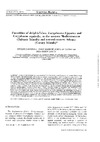Please use this identifier to cite or link to this item:
https://accedacris.ulpgc.es/handle/10553/1061
| Title: | Parasitism of dolphinfishes, Coryphaena hippurus and Coryphaena equiselis, in the western Mediterranean (Balearic Islands) and central-eastern Atlantic (Canary Islands) | Authors: | Carbonell Baldoví, Enrique Massutí, Enric Castro, José Juan García Murcia, Rosa María |
UNESCO Clasification: | 3105 Peces y fauna silvestre | Keywords: | Lampuga (Peces) Parásitos Canarias Life-History Hemiuridae, et al |
Issue Date: | 1999 | Journal: | Scientia Marina | Abstract: | A total of 648 dolphinfishes were examined for internal and external parasites in western Mediterranean (Balearic lslands) and central-eastern Atlantic (Canary lslands) waters in order to make a comparative study between the two areas. The specimens studied from the Mediterranean Sea was Coryphaena hippurus. with 62 large individuals captured from May to September and 497 juveniles captured from August to December. The specimens studied from the central-eastern Atlantic were 39 adult C hippurus and 49 adult Coryphaena equiselis. Parasites were found in 70% of the fish examined. and represented a total of nine endoparasitic taxa: six.. digeneans (Class Trematoda, Subclass Digenea: Dinurus tornatus. Dinurus breviluctus. Dinurus longisinus. Lecithocladium excisum. Bathycotyle branchialis and Hirudinella sp.). two nematodes ( C lass Nematoda. Order Spirurida; Philometroides sp. and Metabromema magna ) and one acanthocephalan (Phyllum Acanthocephala: Rhadinorhynchus pristis). Seven crustacean copepod ectoparasites were identified: Caligus quadratus. Caligus productus, Caligus bonito. Caligus coryphaenae (Family Caligidae) and Euryphorus nymphae (Family Euriphoridae) were found in gill mucus masses or on the inner surface of the operculum. the lernaeopodid Neobrachiella coryphaenae (Family Lernaeopodidae) was attached to gill filaments and the pennellid Penella filosa (Family Pennellidae) was anchored to fins and rays or. deeply. to muscular tissue and abdominal cavity. The relationships between feeding habits. parasite recruitment and parasite transmission were analysed. sorne ecological aspects of all the parasitic species are discussed. and sorne comments are made on parasite-host relationships. | URI: | https://accedacris.ulpgc.es/handle/10553/1061 | ISSN: | 0214-8358 | DOI: | 10.3989/scimar.1999.63n3-4343 | Source: | Scientia Marina [ISSN 0214-8358], v. 63 (3-4), p. 343-354 | URL: | http://dialnet.unirioja.es/servlet/articulo?codigo=2190977 |
| Appears in Collections: | Artículos |
SCOPUSTM
Citations
20
checked on Jun 8, 2025
WEB OF SCIENCETM
Citations
20
checked on Jun 8, 2025
Page view(s)
118
checked on Jan 6, 2024
Download(s)
165
checked on Jan 6, 2024
Google ScholarTM
Check
Altmetric
Share
Export metadata
Items in accedaCRIS are protected by copyright, with all rights reserved, unless otherwise indicated.
